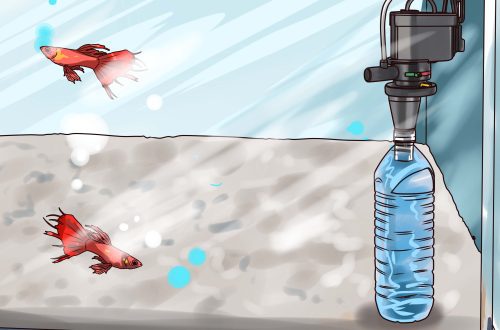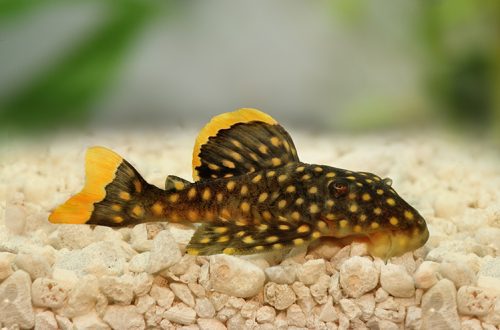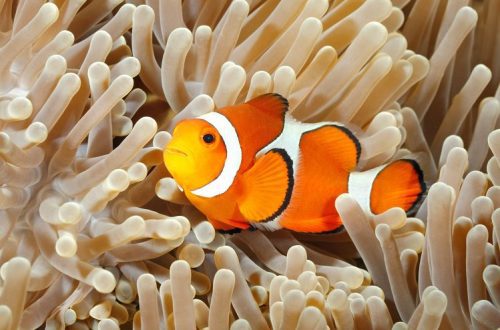
A guide for the beginner aquarist
Caring for an aquarium will be much easier than it seems at first glance, if you follow a few basic rules. Compliance with these postulates will bring your aquarium closer to the natural habitat of your fish.
Contents
Choosing the size of the aquarium
The size of an aquarium depends on several factors. First of all, the dimensions of the room, as well as the desired set of fish, are decisive. Count so that for every cm of fish there was 1 liter of water. Be sure to calculate based on the final size of the fish (check with the pet store to what size your pets will grow). The dimensions of the bottom must be at least 60 cm x 35 cm.
A large aquarium is much easier to care for than a small one.
Placement Locations
Choose a place for the aquarium where you will not move it. Please note that after you fill the aquarium with water and decorations, it will be very difficult for you to move it, and besides, when rearranging it, you can break its integrity.
Do not install the aquarium near the door – the fish will be constantly under stress. The ideal location is far from the window, calm, dark places in the room. If you put an aquarium near a window, then the sunlight will provoke the growth of blue-green algae, and your corner of nature will turn into a blooming swamp.
Installation
Most often, aquarium manufacturers also offer special pedestals-stands. If you are not installing the aquarium on a special cabinet, then make sure that the stand is stable with a perfectly flat horizontal surface (check with a level).
After you have installed the stand, place a soft 5 mm thick polystyrene foam pad on it. The litter will reduce the load on the glass and avoid cracks. Soft foam padding is not required only for aquariums with a special hard plastic frame located around the bottom perimeter.
Preparing the aquarium
A new aquarium must be thoroughly washed before installation. All accessories for the aquarium (buckets, scrapers, sponges, etc.) must not come into contact with detergents and other chemicals. They should only be used for the aquarium. Glass, both inside and out, should never be washed with ordinary household chemicals. It is best to wash the aquarium with hot water and a rag or sponge.
After you have washed the aquarium, fill it with water and leave it for 2-3 hours to check the tightness. If during this time the water does not seep anywhere, then you can continue installation and filling.
Equipment
An aquarium is a small island of nature, therefore, to create the necessary conditions for keeping fish and plants, equipment is needed:
- heater,
- filter,
- compressor,
- thermometer,
- lamp (lighting).
Heater
For most aquarium fish, the normal temperature is 24-26 C. Therefore, the water most often needs to be heated. If your room is warm, and the water in the aquarium without special heating remains at the level of 24-26 C, then you can do without a heater. If central heating does not cope with this task, then you can use aquarium heaters with a thermostat.
Heaters with a regulator themselves maintain the temperature that you set. The heater is sealed, so it must be completely immersed in water in order for the water to wash the heater and heat up evenly (you can only remove the heater from the water after disconnecting from the power source).
The performance of the heater is calculated based on the temperature of the room in which the aquarium is located. In a warm room, where the difference with the water temperature is no more than 3 C, 1 W of heater power per 1 liter of water is enough. The greater the difference in air and water temperatures, the more powerful the heater must be. It is better if the heater is with more power in case it is cold in the room (the total energy consumption for heat generation is the same).
In an aquarium with goldfish, a heater is not needed!
Lamp
Lighting not only serves to better display fish, it also promotes photosynthesis, a vital process for plants. For lighting in freshwater aquariums, fluorescent or light-emitting diode (LED) lamps are mainly used.
A tropical day lasts 12-13 hours, and accordingly, the aquarium should be illuminated for this amount of time. At night, the lighting is turned off, it is most convenient to use a timer for this, which will turn the lamp on and off for you, not forgetting to do this.
Filter
Aquarium filters can be divided into 3 main classes – external, internal and airlifts. The external filter is installed outside the aquarium, usually in a pedestal. Water enters it through hoses and returns back to the aquarium through them. External filters are somewhat more expensive than internal ones, but are much more efficient and do not take up space in the aquarium. Internal filters are cheaper, they cope well with the loads in aquariums with a small number of fish. However, they will require cleaning much more often than external ones. Airlift is ideal for shrimp aquariums, these filters are paired with a compressor.
Compressor (aeration)
Fish breathe oxygen dissolved in the water, so a constant supply of oxygen is necessary with the help of a compressor. It is installed outside the aquarium, connected by a hose to a sprayer, which is installed at the bottom of the aquarium. If the compressor is installed below the water level, a non-return valve must be embedded in the hose to prevent water from entering the compressor in the event of a power outage. The compressor must be of such power that it can pierce the entire water column with a stream of air through the atomizer. It will be useful to install a tap on the hose to adjust the air flow.
Ground
The soil is the basis for successful fish and plant care. It creates a good habitat for the bacteria needed to break down harmful substances. In addition, it holds plants. In order for plants to take root well, it is necessary that there is a constant supply of nutrients. To do this, you can use nutrient soil (like soil). Nutrient soil is distributed over the entire surface of the bottom, and already from above it is covered with fine-grained (3-4 mm) stone gravel.
Stone gravel should be smooth so that fish (for example, catfish) do not get hurt on it. It is desirable that the gravel be dark, because. white causes anxiety and stress in fish. Before pouring gravel into the aquarium, it is necessary to thoroughly rinse it under running water to wash out excess fine particles that can contaminate the water.
Plants
Plants perform several important tasks in an aquarium. Plants create a quality filtration system. Especially fast-growing plants absorb ammonium and nitrate, unloading water. During photosynthesis, plants take in carbon dioxide and oxygenate the water. Also, plants give the aquarium harmony and peace, serve as protection for young fish from hungry neighbors and, being a shelter, help the fish relieve stress.
Plants are planted in such a way that low-growing species are in the foreground. Freestanding shrub plants with tall stems are suitable for the central plan. Tall plants are best placed in the background and on the sides.
Aquarium plants must be transported in water. Before planting, cut the tips of the roots a little with sharp scissors and remove sluggish and damaged leaves. Squeeze a hole in the ground with your finger and carefully insert the roots, sprinkled with gravel. Pack the gravel firmly and pull the plant up slightly to straighten out the roots. After the plants are planted, you can fill the aquarium with water and add a water preparation.
Thanks to the nutritious soil, the plants will quickly take root and grow well. After 4-6 weeks, regular fertilizing should begin. Plants that absorb nutrients through their leaves need a liquid fertilizer. Plants that absorb nutrients through their roots may benefit from a fertilizer tablet.
In an aquarium with herbivorous fish of large species, it is better to replace living plants that form a decorative landscape with artificial ones (to avoid eating them), and among living ones, give preference to fast-growing species.
Water
In nature, in a constant cycle, purification and reproduction of water takes place. In the aquarium, we support this process with special equipment and care products. Water for the aquarium is used ordinary tap water from a cold tap. It is not recommended to use hot tap water and water with silver ions. To prevent erosion of the soil, water is poured onto a plate placed on the bottom.
Tap water must be prepared before pouring into the aquarium!
To prepare water, special conditioners are used (not to be confused with conditioners for washing clothes!), Which bind and neutralize substances in water. There are tools that allow you to put fish into it on the first day after installing the aquarium. If you use a conventional conditioner, then you need to wait 3-4 days after preparing the water, and only then start the fish.
Clearance at customs
Create enough hiding places for the fish. They especially love caves that can be built from large stones, as well as decorative snags, etc. Only specially processed wood snags are suitable for decoration. The wood you collect will rot in the aquarium, releasing harmful substances into the water. Stones containing lime or metal deposits are not suitable. It is better to coat stone buildings with silicone aquarium glue at the points of contact so that they do not fall due to active fish.
Don’t go overboard with the decorations – it’s important to leave enough free space for the fish to swim.
Biological breakdown of harmful substances
From leftover food, fish excrement, dead parts of plants, etc. first formed, according to the pH values, ammonium or ammonia. As a result of the subsequent decomposition, nitrite is formed first, then nitrate. Ammonia and nitrite are very dangerous for fish, especially when starting an aquarium. Therefore, when starting the aquarium, do not forget to pour into the aquarium a special water product containing special nitrifying bacteria that decompose protein degradation products that are dangerous for fish.
Nitrates are not broken down further in the aquarium and filter and therefore accumulate. At high concentrations, they promote the growth of unwanted algae. Too high nitrate values can be reduced by regular water changes (15-20% weekly) and by growing fast growing plants (eg hornwort, elodea) in the aquarium.
Fishes
When buying fish, one should not get carried away only by their appearance, it is necessary to take into account the peculiarities of their behavior, the estimated final size and care features. It is best to combine those fish that are in different layers of water, as well as fish that eat algae and catfish. Most aquarium fish are kept at a water temperature of about 25 C and at a neutral pH (6,5-7,5). In order not to overpopulate the aquarium and correctly calculate the number of fish, it must be taken into account that at the final size, about 1 cm of the length of an adult fish should fall on 1 liter of water.
Only after the aquarium is already decorated, planted with plants; filter, heater and lighting function as expected; tests show good water quality – you can run fish.
Any relocation is a change of environment and always stressful, so the following points should be taken into account:
- Transportation should last no more than 2 hours (if there is no additional air supply).
- When transplanting fish, it is better to turn off the lighting, because. fish are calmer in the dark.
- The change of habitat should occur gradually, therefore, when transplanting, it is not recommended to pour the fish immediately into the aquarium, but it is better to lower the open bag into the water so that it floats, and gradually pour aquarium water into the bag for half an hour.
Feeding
The health and resistance of the body of the fish depends on thoughtful, well-chosen food and the provision of vitamins. The food should be varied, prepared on the basis of quality products.
The amount of food given should correspond to the needs of the fish. Feed should not remain in the water longer than 15-20 minutes. If food still remains, it must be removed with a bottom cleaner to prevent overeating of fish and acidification of water.





